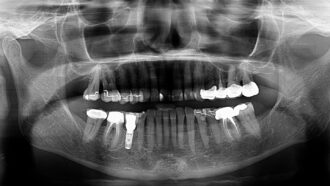
Prosthetic teeth could make great hearing aids.
Vibrations applied to replacements for lost teeth travel well through jawbones to the inner ear, researchers report in the September Journal of the Acoustical Society of America. The finding could lead to discreet alternatives to conventional hearing aids and cochlear implants that people with hearing impairments often use (SN: 7/7/16).
Previous tooth-based hearing aids designs clipped onto molars and received sound wirelessly from a microphone placed behind the ear. Dental researcher Jianxiang Tao and colleagues want to take the concept a step further, turning tooth implants into hearing aids. The electronics that impart sound vibrations would be built into the portion of a false tooth anchored into the jawbone, says Tao, of Tongji University in Shanghai.
But first, the team had to determine how well dental implants transmit sound compared with natural teeth and the mastoid bone behind the ear, which other types of hearing aids rely on to work. So the researchers applied sound tones to the implants, natural teeth and mastoid bones of 38 people with hearing loss and a single dental implant. For a wide range of frequencies, the volunteers could hear sounds through implants as well as, or better than, through natural teeth or mastoid bones, the team reports.
Front-tooth implants appeared to work slightly better than dental implants toward the back of the jaw. That may be because jawbone at the front of the mouth is harder than jawbone at the back, the team speculates. Lower teeth and implants worked as well as uppers for transmitting sound.
Compared with traditional hearing aids, dental implant hearing aids could offer “excellent concealment, good comfort and improved quality of sound,” the researchers write.

 A new treatment could restore some mobility in people paralyzed by strokes
A new treatment could restore some mobility in people paralyzed by strokes  What has Perseverance found in two years on Mars?
What has Perseverance found in two years on Mars?  This robot automatically tucks its limbs to squeeze through spaces
This robot automatically tucks its limbs to squeeze through spaces  Greta Thunberg’s new book urges the world to take climate action now
Greta Thunberg’s new book urges the world to take climate action now  Glassy eyes may help young crustaceans hide from predators in plain sight
Glassy eyes may help young crustaceans hide from predators in plain sight  A chemical imbalance doesn’t explain depression. So what does?
A chemical imbalance doesn’t explain depression. So what does?